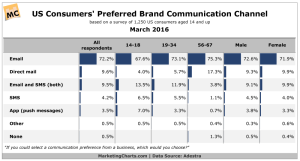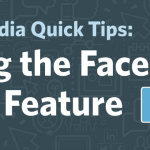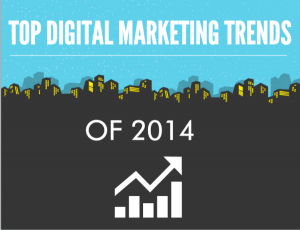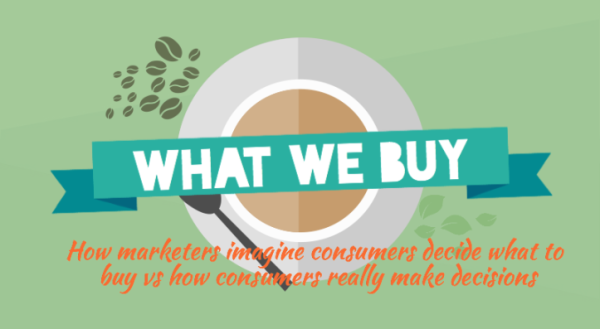
Ever think about how consumer psychology affects buying decisions?
If you think about it at all, you likely think consumers make decisions similar to the ones on the left in this infographic. And, if you’re a marketer, you probably learned consumer psychology that looked something like this (especially for advertising):
Awareness
Interest
Desire
Action
AIDA
Termed AIDA (because marketers love acronyms almost as much as the military), this formula has been taught to marketing students for decades. It’s simple and easy, but also not very insightful. And, in many cases, dead wrong.
AIDA assumes consumers actively seek information about products to make their lives better. And, that may be true in certain situations, but most of the time we’re simply out to have a good time and don’t want to be bombarded with advertising. That’s why we mostly ignore the right hand side of Google search, Facebook’s Newsfeed, and zap through commercials on TV with our TIVOs. We simply don’t want to know about your stuff, so our actual involvement with your brand looks more like the infographic’s right side — we meander aimlessly through our days online and off, not paying much attention to your advertising.
Consumer psychology and social media
That’s why social media, when done right, works so well, especially content marketing. By creating valuable content, you evade consumer defenses against advertising and put your brand right in their newsfeed, search results, and Twitter feed — where consumers are defenseless against your message.
Social media (both owned and earned and some paid) increases consumer exposure to your brand and also creates a great image for your brand, which increases their interest in your products.
Despite increased awareness of your brand through content marketing, slogging through other aspects of consumer psychology, like the consumer decision-making process. create challenges. Overcoming these challenges to consumer psychology potentially explode your ROI.
Consumer psychology challenges
Awareness
Take a look at the infographic’s right side. What you see is a consumer who appears on autopilot and that’s pretty close to the truth. Today’s connected consumer is less focused on your advertising and doesn’t dedicate much effort to processing your message. Instead, they’re using multiple screens — likely watching TV (or their computer monitor via Hulu or Netflix) while checking their Facebook or Flickr feed, chatting with their friends on SnapChat or text message, or checking out their friend’s Pinboards.
Capturing any level of awareness of your brand relies on repeat exposure to your message through an integrated effort combining paid, earned and owned media with traditional advertising.
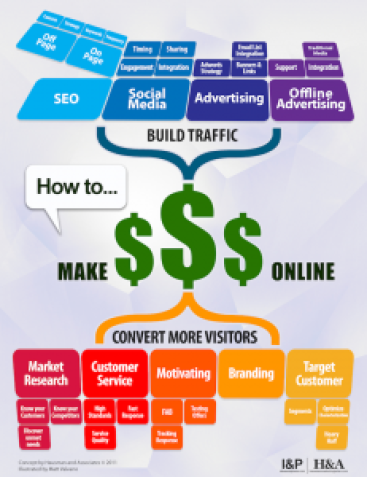
Look at this integrated marketing infographic embedded within the larger infographic. Not only does it highlight the integration of paid, earned, and owned social media with traditional advertising, it shows how SEO, combines with traditional marketing elements such as market research to understand what consumers want, excellent customer service including product quality, branding, market segmentation and target marketing, as well as using tools of influence, CTA (call to action), and other motivational tools.
Interest
Interest relies heavily on creating valuable content, especially when it generates engagement from networked users connected to the consumer.
Content that’s novel, entertaining, and eye-catching works best to generate interest in your brand. That’s why use of video, infographics, memes, and podcasts dramatically increases interest.
A good example of this comes from Talenti, the premium gelato. They create innovative content, such as their wheel that users can spin to determine which flavor to buy. Combined with guerrilla marketing efforts like delivering samples via bicycle at community events, the company is closing in on big names like Ben and Jerry’s in terms of market share.
Desire
Reaching consumer desire relies heavily on a positive brand image and recommendations from a consumer’s social network. Surprisingly, younger consumers consider the tacit endorsements of mere social media acquaintances more than the recommendations of friends and family according to a study. These younger consumers seek user-generated content and are more likely to follow a brand on social networks than family and friends.
That’s some weird consumer psychology — so brands need to up their game to reach these millenials.
Action
Taking action relies more on logistics than consumer psychology. Factors such as pricing (and financing), availability, and the effort necessary to acquire the product precedence at this stage. Simple improvements across these factors reduce the nearly 68% of abandoned online shopping carts.
Online shopping, especially new Facebook shopping options, make it easier for consumers to take action — buy your brand. Reducing the # of clicks required to make a purchase (ie. Amazon’s one click shopping), reducing registration requirements, using easy payment options like PayPal, and offering in-store pickup and exchange all enhance your close rate.
Consumer psychology and analytics
Making improvements in your marketing and communication based on knowing how consumer psychology affects ROI can have a huge impact on your success.
But, what get’s measured, get’s improved. To make the right improvements requires collecting metrics on the right factors.
Consumer psychology tells us there are a wide number of factors impacting conversion (not to mention repeat purchases and average order size) that affect ROI. That means your analytics must focus on the process — the entire consumer journey, not just the end game (conversion). Enhancing metrics related to sentiment, share of voice, and audience growth, as well as your success in reaching influencers and your target market all contribute to your ROI.
As always, leave your questions or comments below and I’m happy to provide more details on how consumer psychology impacts ROI.

Business Articles | Business 2 Community
(456)


